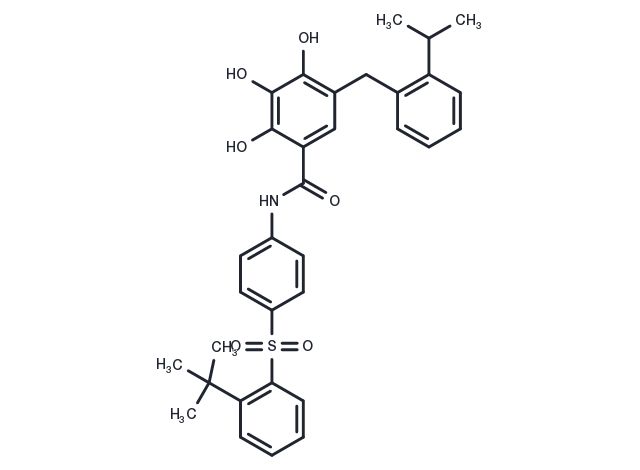Powder: -20°C for 3 years | In solvent: -80°C for 1 year


TW-37 is an nonpeptide inhibitor to recombinant Bcl-2, Bcl-xL and Mcl-1 (Ki: 0.29/1.11/0.26 μM).

| Pack Size | Availability | Price/USD | Quantity |
|---|---|---|---|
| 1 mg | In stock | $ 34.00 | |
| 2 mg | In stock | $ 48.00 | |
| 5 mg | In stock | $ 63.00 | |
| 10 mg | In stock | $ 115.00 | |
| 25 mg | In stock | $ 225.00 | |
| 50 mg | In stock | $ 372.00 | |
| 100 mg | In stock | $ 549.00 | |
| 1 mL * 10 mM (in DMSO) | In stock | $ 97.00 |



| Description | TW-37 is an nonpeptide inhibitor to recombinant Bcl-2, Bcl-xL and Mcl-1 (Ki: 0.29/1.11/0.26 μM). |
| Targets&IC50 | BCL-XL:1.11 μM(Ki), BCL2:0.29 μM(Ki), MCL1:0.26 μM(Ki) |
| In vitro | TW-37 targets the BH3-binding groove in Bcl-2 where proapoptotic Bcl-2 proteins bind, and shows higher affinity and selectivity for Bcl-2 and Mcl-1 over Bcl-xL with Ki values of 0.29 μM, 0.26 μM and 1.11 μM, respectively. [1] In vitro, TW-37 shows significant anti-proliferative and pro-apoptotic effect in a de novo chemo-resistant WSU-DLCL2 lymphoma cell line and primary cells obtained from a lymphoma patient without effects on normal peripheral blood lymphocytes. [1] TW-37 exhibits the inhibitory effect on both cell growth and cell death in endothelial cell with IC50 of approximately 1.8 μM without effect on the fibroblasts exposed to the same concentration range as the endothelial cells. In addition, TW37 also shows the anti-proliferation effects in MCF-7, LNCaP, and SLK tumor cell lines with the same or lower concentration range than those required to inhibit endothelial cell growth. [2] |
| In vivo | TW-37 shows a maximum tolerated dose (MTD) of 40 mg/kg for three i.v. injections in severe combined immunodeficient (SCID) mice when given alone, and enhances tumor inhibitory effect of cyclophosphamide-doxorubicin-vincristine-prednisone (CHOP) regimen. [1] TW-37, administrated by i.v. produces the antiangiogenic effect by decreasing the density of functional human microvessels in the severe combined immunodeficient mouse model of human angiogenesis. [2] The combination of TW-37 and MEK inhibitors synergistically block melanoma cell growth in mice by a significant reduction in tumor volume and tumor mass. [3] |
| Kinase Assay | Fluorescence polarization-based binding assay for recombinant Bcl-2, Bcl-XL, and Mcl-1 protein : For this assay, the 21-residue BH3 peptide QEDIIRNIARHLAQVGDSMDR derived from Bid labeled with 6-carboxyfluorescein succinimidyl ester (FAM-Bid) and recombinant proteins derived from human Bcl-2,Bcl-X L,and Mcl-1 are employed. It is determined that FAM-Bid has a Ki of 11 nM to Bcl-2 protein,25 nM to Bcl-XL protein,and 5.7 nM to Mcl-1 protein. The competitive binding assay for Bcl-XL is same as that for Bcl-2 with the following exceptions: 30 nM Bcl-XL protein and 2.5 nM FAM-Bid peptide in the following assay buffer [50 mM Tris-Bis (pH 7.4) and 0.01% bovine gamma-globulin]. |
| Cell Research | The sulforhodamine B (SRB) cytotoxicity assay is used as described. Briefly, optimal cell density for cytotoxicity assay is determined by growth curve analysis. HDMECs are seeded in a 96-well plate and allowed to adhere overnight. Drug or control is diluted in EGM2-MV and layered onto cells, which are allowed to incubate for times as indicated in the figures. Alternatively, HDMECs are coincubated with TW37 and 0 to 100 ng/mL recombinant human VEGF (rhVEGF)165 or 0 to 100 ng/mL recombinant human CXCL8. Cells are fixed on the plates by addition of cold trichloroacetic acid (10% final concentration) and incubation for 1 hour at 4 °C. Cellular protein is stained by addition of 0.4% SRB in 1% acetic acid and incubation at room temperature for 30 minutes. Unbound SRB is removed by washing with 1% acetic acid and the plates are air dried. Bound SRB is resolubilized in 10 mM unbuffered Tris-base and absorbance is determined on a microplate reader at 560 nm. Test results are normalized against initial plating density and drug-free controls. Data are obtained from triplicate wells per condition and are representative of at least three independent experiments(Only for Reference) |
| Synonyms | TW 37 |
| Molecular Weight | 573.7 |
| Formula | C33H35NO6S |
| CAS No. | 877877-35-5 |
Powder: -20°C for 3 years | In solvent: -80°C for 1 year
DMSO: 57.4 mg/mL (100 mM)
You can also refer to dose conversion for different animals. More
bottom
Please see Inhibitor Handling Instructions for more frequently ask questions. Topics include: how to prepare stock solutions, how to store products, and cautions on cell-based assays & animal experiments, etc.
TW-37 877877-35-5 Apoptosis BCL TW 37 TW37 inhibit Bcl-2 Family Inhibitor inhibitor
